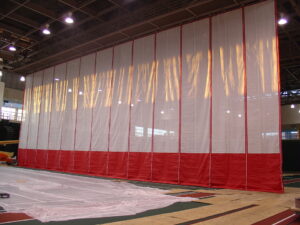Properly storing athletic netting can prevent unnecessary wear caused by the elements, which will lengthen its service life.

Prevent Winter Damage
Cold weather can stiffen synthetic fibers. That makes them brittle and prone to fraying and breaking. Snow accumulation also strains athletic netting, which can warp the fibers. That alters the net’s integrity, which is essential for keeping spectators safe.
Exposure to rain, snow and ice increases the chance of mold and mildew growth, which can discolor sports netting and leave it looking shabby and worn out.
Extended Lifespan
Packing sports netting away for the off-season reduces the likelihood of physical damage caused by blowing debris and falling objects, as well as the need for repairing or replacing the netting. Tangling can damage netting, especially if you yank while trying to unravel a knot.
Protection from Animals
The woven fibers in athletic netting are perfect nest materials for mice, birds and other animals. Store them in sealable containers and elevate them off the floor of your storage space. Avoid cardboard boxes as rodents can chew through that material.
Keep the storage area clean and periodically check for signs of nests and animal droppings. You may need to install traps in and around your storage facility to keep animals away.
Preventing UV Degradation
The sun’s UV rays weaken netting fibers and reduce the strength of the material. Long-term exposure can decrease the lifespan of sports netting if it hangs in the sun year-round.
High-density polyethylene, polypropylene or polyester netting are designed to withstand the sun’s harsh rays. You can also apply a UV protectant to reduce damage and discoloration.
Easier Inspections and Maintenance
Proactive inspections and maintenance allow you to address minor issues before they become bigger problems. They also reduce the likelihood of having to completely replace your athletic netting.
Conduct thorough inspections before storing your equipment. Watch for:
- Loose threads
- Holes
- Detachment at connection points
- Fraying seams, edges and corners
- Sagging or stretching
- Broken hooks, clips and carabiners
Use a brush or leaf blower to clear debris, working down from the top of the net. You can use a mild detergent to scrub mold and mildew away, but avoid using harsh chemicals. Consult the manufacturer’s guidelines for specific maintenance instructions.
Athletic Netting from Tiffin Scenic
We offer athletic netting systems for batting cages, driving ranges, hockey arenas and more. Contact our expert team to learn about our design and installation services.